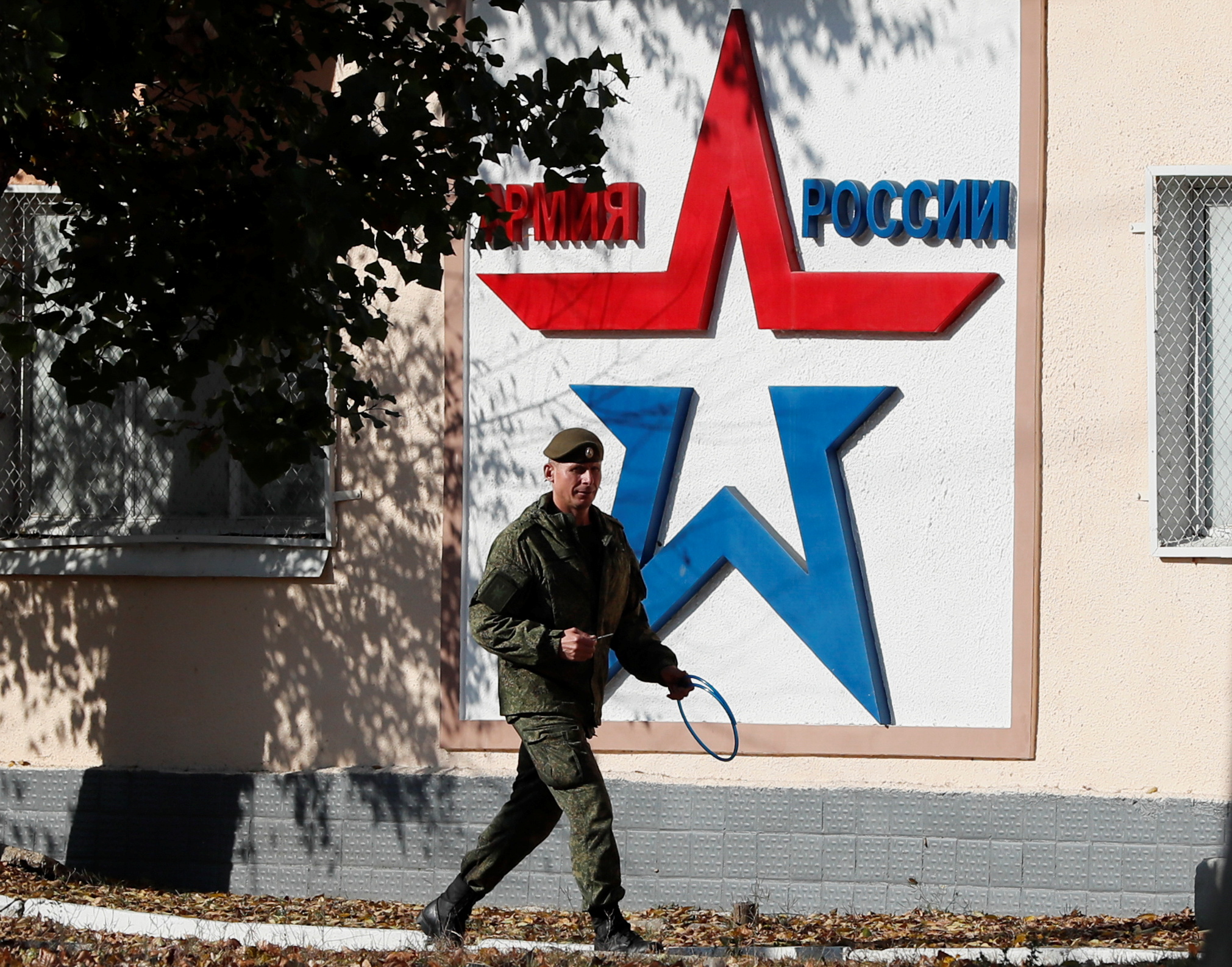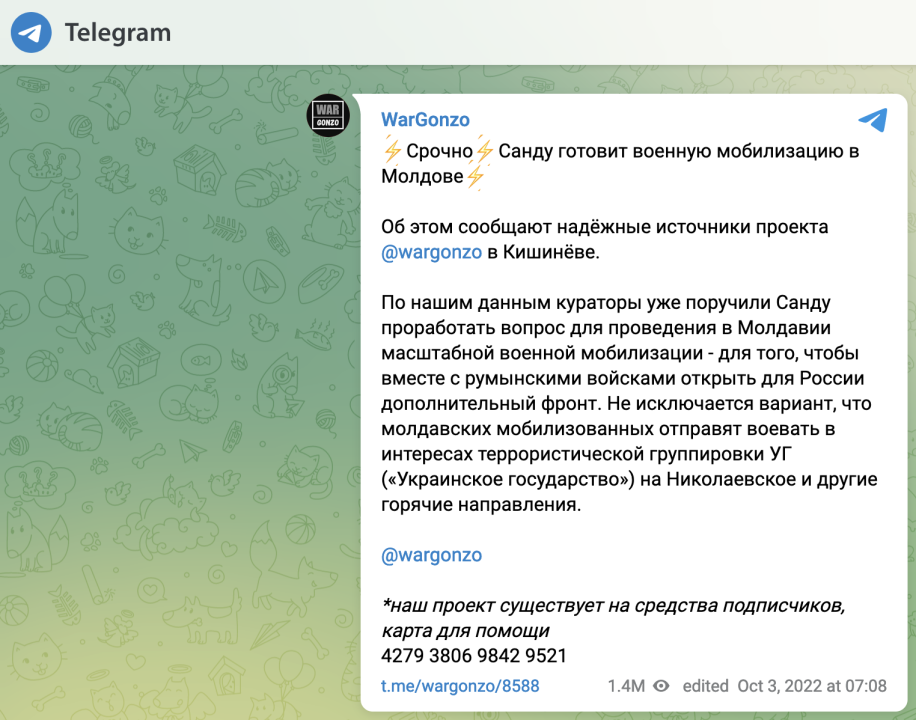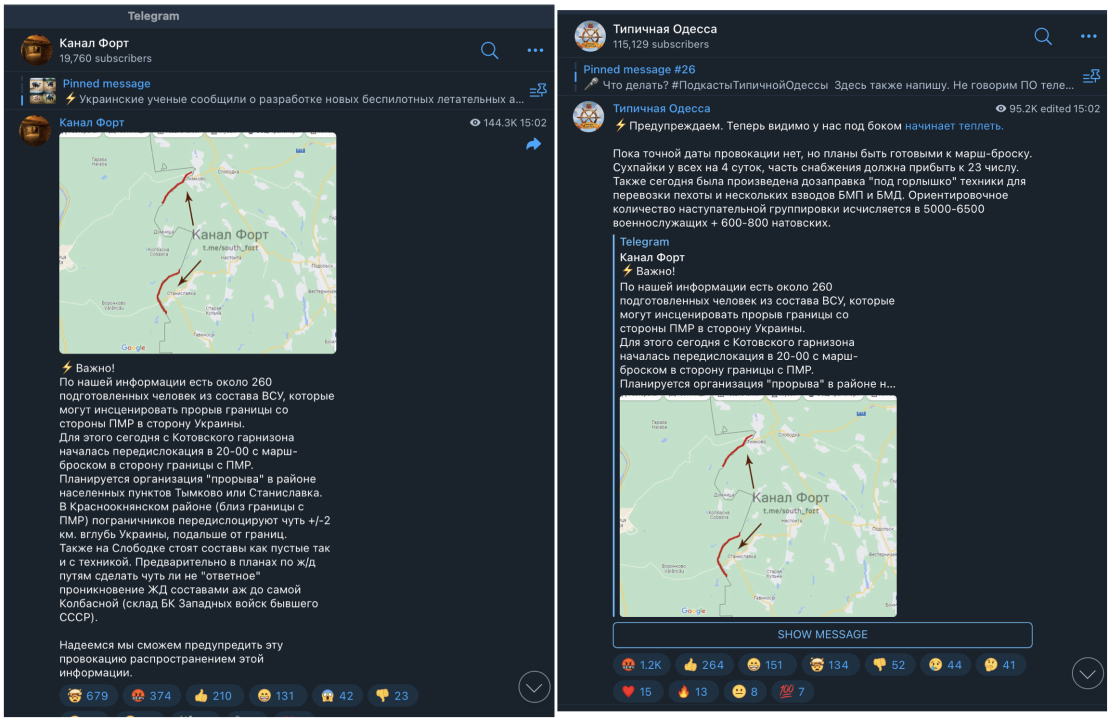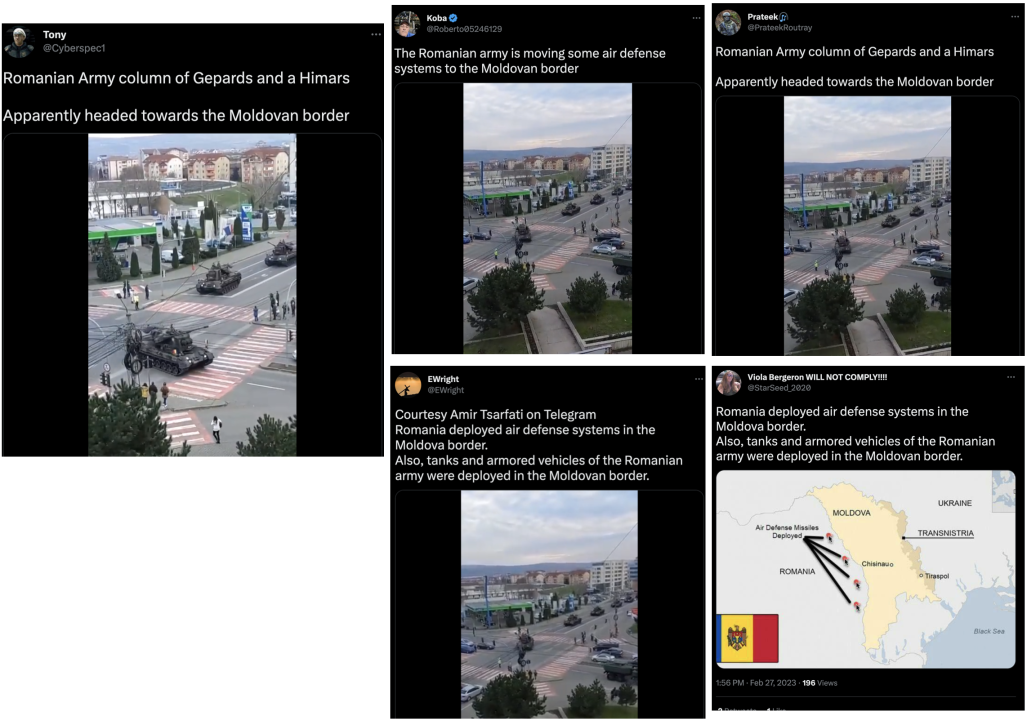Russia builds a “special information operation” around Transnistria
Rhetoric increasingly pushes idea of military conflict in the separatist region of Moldova
Russia builds a “special information operation” around Transnistria
Share this story

BANNER: A Russian serviceman walks past the Operational Group of Russian Forces headquarters in Tiraspol, in Moldova’s self-proclaimed separatist Transnistria, November 3, 2021. The banner reads “Army of Russia.” (Source: REUTERS/Gleb Garanich)
Intent on sowing discord in Moldova and providing a supposed rationale for intervention, the Kremlin is flooding the country’s information space with narratives designed to undermine support for its pro-Western government.
Russia has intentionally heightened the level of tension in the region by pushing alarmist narratives, spreading messages across multiple platforms, and using state media as amplifiers. As part of this information operation, Kremlin-affiliated Telegram channels created false alarms, disseminated forged documents, and misinterpreted facts.
The Republic of Moldova has been in a precarious situation as a collateral victim of Russia’s war against Ukraine since that conflict’s inception. An estimated 405 kilometers of Moldova’s 1,222-kilometer shared border with Ukraine are under the control of separatist authorities in Transnistria, where the Russian Federation maintains a force of 1,500 soldiers. In the spring of 2022, early in Russia’s Ukraine invasion, Russian Major General Rustam Minnekaev openly admitted that one of the goals of Moscow’s “special military operation” was the creation of a land corridor to Transnistria.
Besides a Soviet past, Moldova and Ukraine share a similar traumatic experience of a war in which Russia played a direct role. After the 1992 war in Transnistria in which Moscow sided with separatist forces, Moldova succumbed to Russian pressure and included a guarantee for permanent neutrality in its 1994 Constitution. The plan was to barter neutrality in exchange for Russian troop withdrawals from the region, but these withdrawals never took place, as evident in Russia’s continuing military presence in the region.
Arguing on the principle of Moldova’s constitutionally mandated neutrality, Russia has consistently stifled support for Moldova’s efforts to increase its defense and military capabilities. Pro-Kremlin propaganda in Chisinau has targeted Moldova with a narrative that it does not need an army because it is a neutral nation. Critics claim that successive Moldovan governments, under the pretext of neutrality, have deliberately ignored the security and defense sectors over the years, refusing to acknowledge the evolving Russian threat. This paradigm, however, shifted dramatically due to the war in Ukraine. To face the existing threat and increase the country’s defense capabilities, the pro-Western government of Moldova requested support from the European Union, NATO, and those NATO member states with which it has long-term partnerships.
Russia, for its part, showed discontent at every announcement of military aid for Moldova. In December 2022, in an interview with RIA Novosti, Russian Deputy Foreign Minister Mihail Galuzin said that NATO’s plans to provide Moldova with weapons threaten to lead to “catastrophe.”
Russia’s attempts to incite new hostilities around the Republic of Moldova and in the region have been more blatant in recent months. The Transnistria region has recently been at the forefront of Russian media attention. On February 23, 2023, the Russian Ministry of Defense’s Telegram channel posted information about a supposed Ukrainian attack on the separatist region. The news quickly spread around the internet. High-ranking Russian officials and the state media subsequently disseminated the allegations widely on numerous Telegram channels, leading both Moldovan and Ukrainian officials to refute the allegations.
Although it may appear that Moscow’s statements sprang out of nowhere, the themes of the information operation were laid some months in advance. The DFRLab identified two of the most common narratives in statements from Russian officials, Kremlin-affiliated media, and pro-Russian Telegram channels, as well as the engagement of pro-Russian political forces in Moldova, to understand how Moscow prepared and established the belligerent information around Moldova’s Transnistria region.
Narrative 1: The West is weaponizing Moldova to wage a war in Transnistria
Russian narratives related to Moldova generally emphasize the country’s militarization, questioning Chisinau’s right to consolidate its defense capabilities. For its part, Moscow claims that the West is preparing Moldova to enter the war and that the country has become overly militarized, which, according to the Kremlin, poses a danger for the Transnistrian region, Russian citizens, and the Russian military in the area.
During the last year, Kremlin-affiliated Russian-language news portals posted a series of articles and analyses aimed at amplifying the topic of the militarization of Moldova. Between May and September 2022, Eadaily.com, a website known for promoting the Kremlin’s narratives, ran a series of articles highlighting how the United States, the EU, and the United Kingdom are arming Moldova. On June 8, Eadaily published the article “Russia is worried about how aggressively Moldova is being pushed into NATO,” in which the author quotes Russian Foreign Ministry spokeswoman Maria Zakharova, who claimed that NATO supplying Moldova with weapons does not cohere with the neutral status of the republic. The article’s authors also noted the increased allocation in the country’s budget toward national defense, causing Moscow to doubt its intentions.

In another post, titled “The United States Arms Moldova for War with Transnistria,” the same outlet accused the US of arming Moldova for it to wage war with Transnistria. According to the sources cited in the article, US weapons delivered to the National Army of Moldova look like a “deliberate and objectively threatening demarche,” increasing the risk of a new military conflict between Moldova and Transnistria.
On October 5, 2022, Vzglyad (vz.ru), which is run by the Russian Presidential Administration-affiliated Institute of Experts for Social Research, published the article “NATO prepares to arm Moldova.” The paper examined the military support that the EU and NATO nations have provided Moldova and alleged that increasingly militaristic rhetoric from Chisinau has alarmed Russia and the separatist authorities in Transnistria, who have voiced skepticism that these actions will contribute to the Republic of Moldova’s security. On February 2, 2023, the same website published an analytical note suggesting that Moldova might become another hot spot on the European map “if Chisinau receives from Washington the ‘go ahead’ command” to attack Transnistria.
Narrative 2: NATO and Ukraine are preparing to open a second front in Transnistria
Besides a purported danger from Moldova, Russia has built several alternative scenarios around Transnistria, including the involvement of third parties like Romania (a NATO member) and Ukraine. Russian Telegram channels frequently spread speculation concerning Romanian military participation in the conflict.
On February 14, when Moldova’s airspace was temporarily closed due to the detection of “an unidentified small object,” Telegram channel Старая площадь (“Old Square”), which has 136,000 subscribers, published a panic-inducing message stating in Russian, “Moldova is on the verge of some terrible events. All civilian planes have disappeared from the sky…Under the leadership of President Maia Sandu [a Romanian citizen], a conflict with Transnistria with the participation of British special services will be provoked. After that, Romanian troops will enter the territory of Moldova under the guise of military assistance to the ‘fraternal’ people.”

Previously in October 2022, a well-known Russian Telegram channel called WarGonzo wrote, “The [Western] curators have directed [Moldovan President] Sandu to work out the details of a large-scale military mobilization in Moldova to build a second front for Russia alongside Romanian forces.”

Although the possibility of a Ukrainian military intervention in Transnistria has been discussed on a regular basis in pro-Russian networks over the last year, it gained momentum at the end of January 2023. On January 31, Vzglyad published an interview with Transnistrian Foreign Minister Vitaly Ignatiev titled “The militarization of Moldova is a threat.” In the interview, Ignatiev highlighted Moldova’s ongoing militarization as a form of Chisinau’s pressure on Transnistria. He also said that he does not rule out the possibility that the first assault on the unrecognized republic would be made not by the Moldovan army but by the Ukrainian one.
To stir up talk of an impending Ukrainian attack on Transnistria, Moscow also used Ukrainian channels linked to the Kremlin. On February 21, Ukrainian blogger Anatoly Shariy, whom Ukrainian authorities charged with high treason, uploaded a video to YouTube called “Transnistria may blaze.” A few hours later, he published information to his Telegram channel from unidentified sources about the movement of Ukrainian forces near the country’s border with Transnistria. Shariy’s Telegram channel has more than a million subscribers.
Around the same time, Telegram channel Канал Форт (“Canal Fort”) claimed that over 260 Ukrainian soldiers had been sent to the Transnistrian border to attack the territory near the village of Cobasna, where a massive Soviet-era ammunition depot is located. Almost immediately, Telegram channel Typical Odesa shared Canal Fort’s post, claiming that “the number of Ukrainian offensive groups is estimated at 5,000–6,500, plus around 600–800 NATO troops.” An analysis of incoming and outgoing mentions using TGStat showed that the Canal Fort and Typical Odessa channels routinely reference each other. The Ukrainian security service arrested Typical Odesa admin Alexander Sinitsyn on February 27, 2023, as part of its investigation into the Russian spy network that intentionally promotes Kremlin propaganda.

Later, another pro-Russian Telegram channel, Vorpost, which has almost 103,000 subscribers, referred to information published by Canal Fort, stating that the Ukrainian plan provides for a staged attack by the RF Armed Forces from Transnistria as a pretext for the Ukrainian army to invade the separatist region. The Kremlin adopted this version as its official narrative two days later on February 23, when the Russian Ministry of Defense warned that Ukraine was planning provocative actions in Transnistria. Russian state media, including 1TV, NTV, TASS, Vedomosti.ru, and RIA, as well as their affiliated Telegram channels from Moldova and the Transnistria region, quickly amplified the official statement.
The narrative was also quickly adopted by Moldovan pro-Russian politicians, who accused Ukraine of warmongering. In a video posted on his Telegram channel, former Moldovan President Igor Dodon, who is known for his pro-Russian position, stated, “We will deal with Transnistria ourselves. This is our territory, our country. We will solve this problem ourselves, peacefully. Not the way they want. They want to bring in troops and so on.” Ilan Shor, another opposition politician who is accused of organizing anti-government protests at the behest of the Russian secret service, used the same rhetoric, accusing the Moldovan government of conspiring with the Ukrainian authorities. “[President] Maia Sandu is trying to drag Moldova into a war with Russia; she is doing everything possible, at any cost, to spill blood on the territory of Moldova, just to stay in power,” Sor said in a video posted to his Facebook page. In the video, he also called on the population to protest: “Say NO to war, NO to the shedding of blood, NO to the murder of the Moldovan people in the name of the interests of Maia Sandu and her gang!”.
On Sunday, February 26, a post on the Novorossia_Region Telegram channel stated, “The Ukronazi regime in Kyiv, stirred up by the American military, is preparing an armed provocation against Transnistria.” As supposed proof, it showed a picture of what it claimed to be a document from the Ukrainian army. The Center for Strategic Communications and Information Security of Ukraine, however, denied the veracity of the document. Declaring that through this fake, “the propagandists are trying to discredit the Armed Forces of Ukraine.” According to the institution, the document does not correspond to the standard model used by the military command of Ukraine, and the wording in the document does not correspond to formal Ukrainian, including grammatical errors.
On February 27, the Canal Fort channel published a video titled “The Romanian anti-aircraft missile system is advancing to the border (with Moldova).” In the video, with a Romanian war song in the background, a column of military equipment can be seen moving through the central streets of a Romanian city. The same video, with the same description, was uploaded to a YouTube channel called Anonymous Network | News, which was created on February 27, 2023. The video was also actively circulated on Twitter by openly pro-Russian or far-right accounts, as well as ones that spread COVID-19 conspiracy narratives. The GeoConfirmed twitter account geolocated the video as being from Alba Iulia, 500km away from the border with Moldova. The Romanian Ministry of Defense also reported the fake. According to the statement, the video material with military equipment were indeed filmed in the Romanian city of Alba Iulia. However, it was shot at the end of November 2022, during the preparation of the military ceremony organized on Romania’s National Day, and not on the morning of February 27, as the authors of the fake posts claimed.

In the following days, Russian authorities continued to raise tensions around Transnistria with new warnings and accusations against “the United States, NATO members, and their Ukrainian proxies.” On February 24, the Russian defense ministry issued a statement saying, “Any actions that pose a threat to our compatriots, the Russian peacekeeping contingent, the Operational Group of Russian Forces, and military depots in Colbasna will be considered, in accordance with international law, an attack on the Russian Federation.” Later, foreign ministry spokeswoman Maria Zakharova expressed concern about the possibility of delivering radioactive substances to Ukraine through the ports of Odesa and Chernomorsk, fearing a provocation in Transnistria.
Moscow’s rhetoric in recent months has been increasingly provocative. Its push of inflammatory and escalatory narratives is supported by a complex information ecosystem in Moldova, which includes state representatives, media outlets, social media platforms, and influencers with vested interests working to create, disseminate, and amplify Kremlin-induced narratives. This disinformation campaign exacerbates the regional security situation and undermines Moldova’s internal political stability, as exemplified by the protests held by pro-Russian opposition forces intent on forcing a state coup.
Cite this case study:
Victoria Olari, “Russia builds a ‘special information operation’ around Transnistria,” Digital Forensic Research Lab (DFRLab), March 20, 2023, https://dfrlab.org/2023/03/20/russia-builds-a-special-information-operation-around-transnistria.

